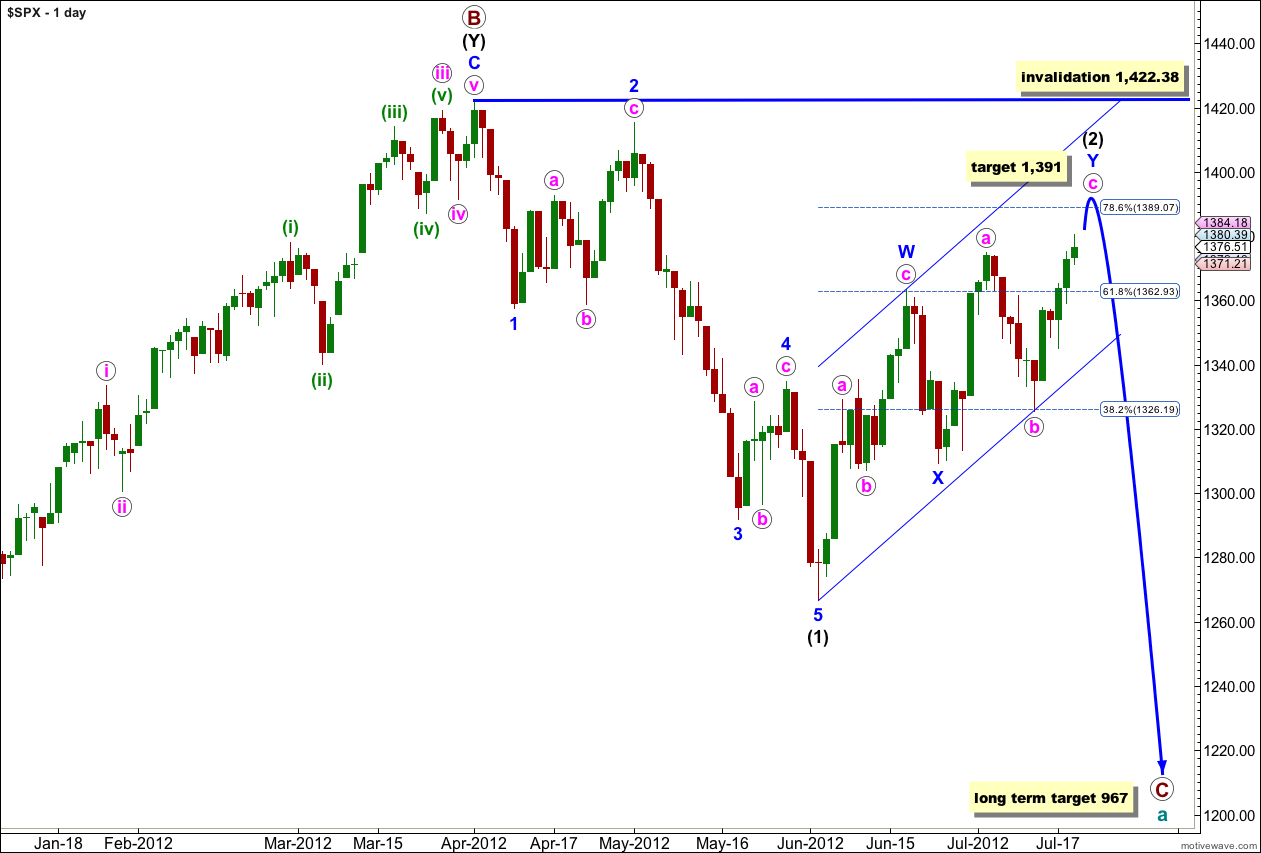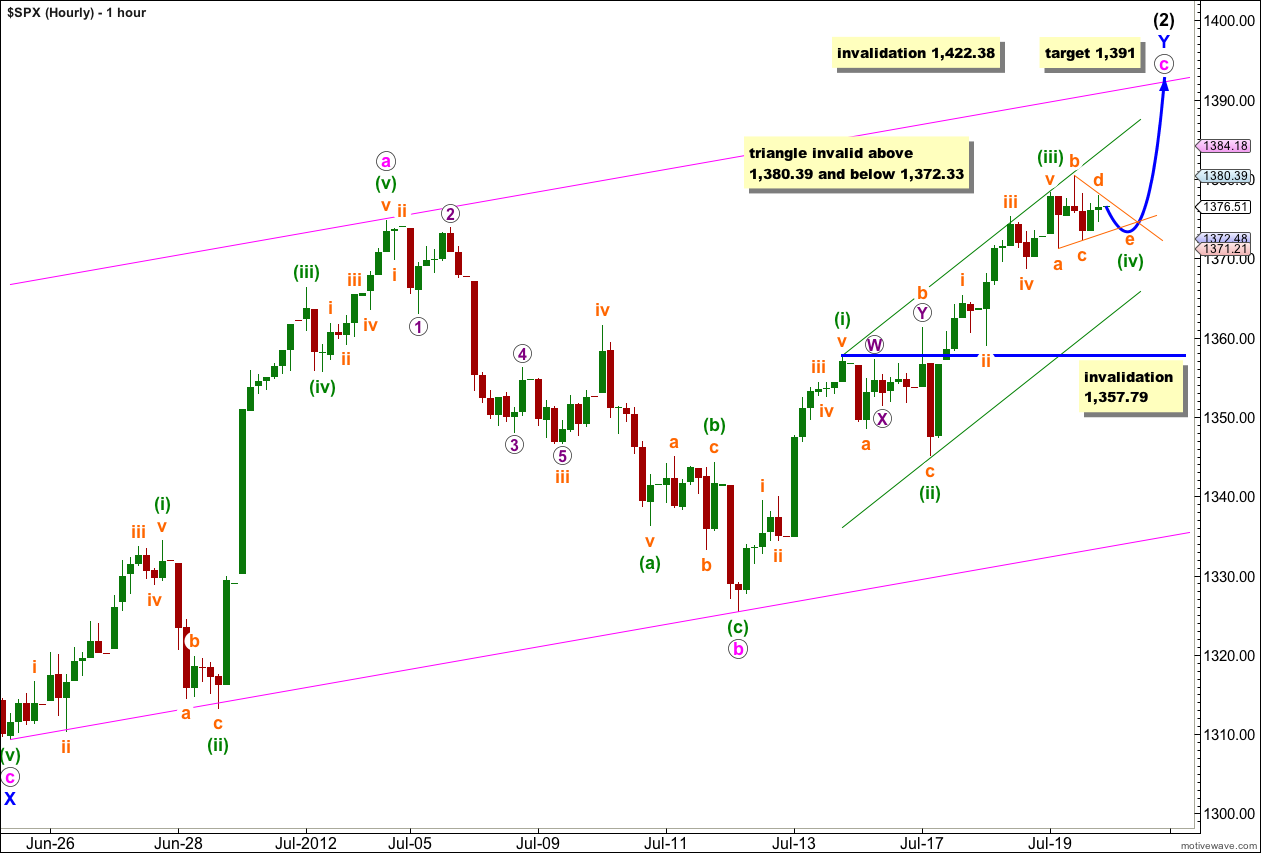Last analysis had only one daily and one hourly wave count for the S&P 500. I expected upwards movement to a small 1 point target zone at 1,378 – 1,379 to begin Thursday’s trading session. Price rose to 1,378.23 before moving sideways and slightly higher for the rest of the session.
At this stage the structure is unfolding as expected.
Click on the charts below to enlarge.
This wave count sees a big trend change at the price high of 1,422.38. Primary wave C should make substantial new lows below the end of primary wave A which had its low at 1,074.77. Primary wave C would reach 1.618 the length of primary wave A at 967, completing a typical expanded flat for cycle wave a.
Within primary wave C wave (1) black is a complete five wave impulse downwards. Wave (2) black is unfolding as a double zigzag structure. The purpose of a double zigzag is to deepen a correction. At this stage the final structure of wave Y blue, the second zigzag, is still incomplete and may yet take a few more days to unfold.
The parallel channel about wave (2) black is a best fit to contain all this upwards movement. When we have a clear channel breach with a full daily candlestick below the channel then we may have confirmation that (2) black would be over and (3) black would be underway.
Wave (2) black may not move beyond the start of wave (1) black. This wave count is invalidated with movement above 1,422.38.
Thursday’s session saw price behave pretty much as expected. The structure for wave (iii) green may now be seen as complete. The small parallel channel drawn on yesterday’s hourly chart about wave (iii) green was breached towards the end of Thursday’s session with sideways movement. This indicates that wave (iii) green is over and wave (iv) green has begun.
I have redrawn the channel to contain wave c pink. The first trend line is drawn from the highs of waves (i) to (iii) green, then a parallel copy is placed upon the low of wave (ii) green. We may expect wave (iv) green to remain within this channel, and if it moves lower it should find support at the lower end of the channel. Wave (v) green upwards should end either mid way within the channel or at its upper edge. After wave (v) green is complete and this channel is breached by downwards movement that shall be our very first indication of a possible trend change with the end of wave (2) black.
Wave (iii) green is just 0.73 points longer than equality with wave (i) green. This means that there is no limit to the length of wave (v) green (other than the invalidation point at 1,422.38) because the third wave will not be the shortest.
Ratios within wave (iii) green are: there is no Fibonacci ratio between waves i and iii orange, and wave v orange is just 0.68 points short of 0.618 the length of wave iii orange.
At this stage on the 5 minute chart it looks like wave (iv) green may be unfolding as a contracting running triangle. However, as I have said before I have seen so many triangle structures invalidate themselves at the very end and turn out to be double combinations or double flats. For this reason I will leave the invalidation point at 1,357.79. Any further downwards movement of wave (iv) green may not move into wave (i) green price territory.
For the triangle to remain valid it requires a final e wave downwards. Prior to this any further upwards movement of wave d orange may not move beyond the end of wave c orange at 1,380.39. However, if wave d orange moves higher for a barrier triangle then it may in practicality move very slightly above the end of wave d orange at 1,380.39, as long as the b-d trend line is essentially flat, so this upper triangle invalidation point is not completely firm (unlike the lower point). Wave e orange downwards may not move beyond the end of wave c orange at 1,372.33, not even by a fraction of a point. Wave e orange should either undershoot or (more likely) overshoot the a-c trend line.
If the triangle remains valid and completes a small wave e orange downwards then we shall have a high probability of knowing the next movement should be a sharp upwards thrust. If wave (iv) green completes as a triangle, because only the e wave is needed at this stage, it should end early next session. The end of wave (2) black in its entirety could be only a couple of sessions away.
If the triangle remains valid then keep drawing the trend lines about it, extending them out to the right. At the point in time at which the trend lines cross over expect a trend change.
If the triangle is invalidated then a double flat or double combination for wave (iv) green would be more time consuming, and it should last another one to two sessions. It would be likely to end about the fourth wave of one lesser degree which is at 1,368.7, and a little below this point. It should find support at the lower end of the smaller green parallel channel.
At this stage the target for this upwards movement to end remains at 1,391 where wave c pink would reach equality in length with wave a pink. When I know where wave (iv) green has ended then I will use ratios at green degree to refine this target, so it will probably change.


